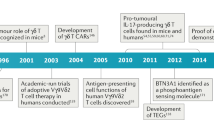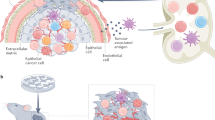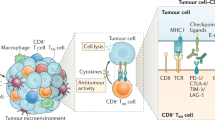Abstract
Clinicians and scientists have long questioned whether the immune system has a role in destroying cancerous tissue. Studies performed in animal models have, however, recently revealed that the immune system can, at least in principle, effectively control tumours. In parallel with these findings, a large body of evidence indicates that although the immune system has the capacity to control tumours, there are also regulatory mechanisms that subdue these responses. A major challenge of tumour immunotherapy, therefore, is to find ways of disabling these regulatory functions while restoring or priming any immune responses that are protective.
This is a preview of subscription content, access via your institution
Access options
Subscribe to this journal
Receive 50 print issues and online access
$259.00 per year
only $5.18 per issue
Buy this article
- Purchase on Springer Link
- Instant access to full article PDF
Prices may be subject to local taxes which are calculated during checkout

Similar content being viewed by others
References
Antony PA, Piccirillo CA, Akpinarli A, Finkelstein SE, Speiss PJ, Surman DR et al. (2005). CD8+ T cell immunity against a tumor/self-antigen is augmented by CD4+ T helper cells and hindered by naturally occurring T regulatory cells. J Immunol 174: 2591–2601.
Apostolou I, Sarukhan A, Klein L, von Boehmer H . (2002). Origin of regulatory T cells with known specificity for antigen. Nat Immunol 3: 756–763.
Aschenbrenner K, D'Cruz LM, Vollmann EH, Hinterberger M, Emmerich J, Swee LK et al. (2007). Selection of Foxp3+ regulatory T cells specific for self antigen expressed and presented by Aire+ medullary thymic epithelial cells. Nat Immunol 8: 351–358.
Asselin-Paturel C, Echchakir H, Carayol G, Gay F, Opolon P, Grunenwald D et al. (1998). Quantitative analysis of Th1, Th2 and TGF-beta1 cytokine expression in tumor, TIL and PBL of non-small cell lung cancer patients. Int J Cancer 77: 7–12.
Asseman C, Mauze S, Leach MW, Coffman RL, Powrie F . (1999). An essential role for interleukin 10 in the function of regulatory T cells that inhibit intestinal inflammation. J Exp Med 190: 995–1004.
Azuma T, Takahashi T, Kunisato A, Kitamura T, Hirai H . (2003). Human CD4+ CD25+ regulatory T cells suppress NKT cell functions. Cancer Res 63: 4516–4520.
Bettelli E, Carrier Y, Gao W, Korn T, Strom TB, Oukka M et al. (2006). Reciprocal developmental pathways for the generation of pathogenic effector TH17 and regulatory T cells. Nature 441: 235–238.
Betts G, Twohig J, Van den Broek M, Sierro S, Godkin A, Gallimore A . (2007). The impact of regulatory T cells on carcinogen-induced sarcogenesis. Br J Cancer 96: 1849–1854.
Betts GJ, Clarke SL, Richards HE, Godkin AJ, Gallimore AM . (2006). Regulating the immune response to tumours. Adv Drug Deliv Rev 58: 948–961.
Beyer M, Kochanek M, Giese T, Endl E, Weihrauch MR, Knolle PA et al. (2006). In vivo peripheral expansion of naive CD4+CD25high FoxP3+ regulatory T cells in patients with multiple myeloma. Blood 107: 3940–3949.
Bopp T, Becker C, Klein M, Klein-Hessling S, Palmetshofer A, Serfling E et al. (2007). Cyclic adenosine monophosphate is a key component of regulatory T cell-mediated suppression. J Exp Med 204: 1303–1310.
Brunkow ME, Jeffery EW, Hjerrild KA, Paeper B, Clark LB, Yasayko SA et al. (2001). Disruption of a new forkhead/winged-helix protein, scurfin, results in the fatal lymphoproliferative disorder of the scurfy mouse. Nat Genet 27: 68–73.
Bui JD, Uppaluri R, Hsieh CS, Schreiber RD . (2006). Comparative analysis of regulatory and effector T cells in progressively growing versus rejecting tumors of similar origins. Cancer Res 66: 7301–7309.
Chen ML, Pittet MJ, Gorelik L, Flavell RA, Weissleder R, von Boehmer H et al. (2005). Regulatory T cells suppress tumor-specific CD8T cell cytotoxicity through TGF-beta signals in vivo. Proc Natl Acad Sci USA 102: 419–424.
Chen W, Jin W, Hardegen N, Lei KJ, Li L, Marinos N et al. (2003). Conversion of peripheral CD4+CD25− naive T cells to CD4+CD25+ regulatory T cells by TGF-beta induction of transcription factor Foxp3. J Exp Med 198: 1875–1886.
Clarke SL, Betts GJ, Plant A, Wright KL, El-Shanawany TM, Harrop R et al. (2006). CD4+CD25+FOXP3+ regulatory T cells suppress anti-tumor immune responses in patients with colorectal cancer. PLoS ONE 1: e129.
Conrad CT, Ernst NR, Dummer W, Brocker EB, Becker JC . (1999). Differential expression of transforming growth factor beta 1 and interleukin 10 in progressing and regressing areas of primary melanoma. J Exp Clin Cancer Res 18: 225–232.
Curiel TJ, Coukos G, Zou L, Alvarez X, Cheng P, Mottram P et al. (2004). Specific recruitment of regulatory T cells in ovarian carcinoma fosters immune privilege and predicts reduced survival. Nat Med 10: 942–949.
Curti A, Pandolfi S, Valzasina B, Aluigi M, Isidori A, Ferri E et al. (2007). Modulation of tryptophan catabolism by human leukemic cells results in the conversion of CD25− into CD25+ T regulatory cells. Blood 109: 2871–2877.
Dannull J, Su Z, Rizzieri D, Yang BK, Coleman D, Yancey D et al. (2005). Enhancement of vaccine-mediated antitumor immunity in cancer patients after depletion of regulatory T cells. J Clin Invest 115: 3623–3633.
Darnell RB, Posner JB . (2003). Paraneoplastic syndromes involving the nervous system. N Engl J Med 349: 1543–1554.
Davidson TS, DiPaolo RJ, Andersson J, Shevach EM . (2007). Cutting Edge: IL-2 is essential for TGF-beta-mediated induction of Foxp3+ T regulatory cells. J Immunol 178: 4022–4026.
Deaglio S, Dwyer KM, Gao W, Friedman D, Usheva A, Erat A et al. (2007). Adenosine generation catalyzed by CD39 and CD73 expressed on regulatory T cells mediates immune suppression. J Exp Med 204: 1257–1265.
Derbinski J, Schulte A, Kyewski B, Klein L . (2001). Promiscuous gene expression in medullary thymic epithelial cells mirrors the peripheral self. Nat Immunol 2: 1032–1039.
DiPaolo RJ, Brinster C, Davidson TS, Andersson J, Glass D, Shevach EM . (2007). Autoantigen-specific TGFbeta-induced Foxp3+ regulatory T cells prevent autoimmunity by inhibiting dendritic cells from activating autoreactive T cells. J Immunol 179: 4685–4693.
Erdman SE, Poutahidis T, Tomczak M, Rogers AB, Cormier K, Plank B et al. (2003). CD4+ CD25+ regulatory T lymphocytes inhibit microbially induced colon cancer in Rag2-deficient mice. Am J Pathol 162: 691–702.
Erdman SE, Sohn JJ, Rao VP, Nambiar PR, Ge Z, Fox JG et al. (2005). CD4+CD25+ regulatory lymphocytes induce regression of intestinal tumors in ApcMin/+ mice. Cancer Res 65: 3998–4004.
Fantini MC, Rizzo A, Fina D, Caruso R, Becker C, Neurath MF et al. (2007). IL-21 regulates experimental colitis by modulating the balance between T(reg) and Th17 cells. Eur J Immunol 37: 3155–3163.
Fontenot JD, Gavin MA, Rudensky AY . (2003). Foxp3 programs the development and function of CD4+CD25+ regulatory T cells. Nat Immunol 4: 330–336.
Ghiringhelli F, Menard C, Terme M, Flament C, Taieb J, Chaput N et al. (2005a). CD4+CD25+ regulatory T cells inhibit natural killer cell functions in a transforming growth factor-beta-dependent manner. J Exp Med 202: 1075–1085.
Ghiringhelli F, Puig PE, Roux S, Parcellier A, Schmitt E, Solary E et al. (2005b). Tumor cells convert immature myeloid dendritic cells into TGF-beta-secreting cells inducing CD4+CD25+ regulatory T cell proliferation. J Exp Med 202: 919–929.
Girardi M, Oppenheim DE, Steele CR, Lewis JM, Glusac E, Filler R et al. (2001). Regulation of cutaneous malignancy by gammadelta T cells. Science 294: 605–609.
Gondek DC, Lu LF, Quezada SA, Sakaguchi S, Noelle RJ . (2005). Cutting edge: contact-mediated suppression by CD4+CD25+ regulatory cells involves a granzyme B-dependent, perforin-independent mechanism. J Immunol 174: 1783–1786.
Hsieh CS, Liang Y, Tyznik AJ, Self SG, Liggitt D, Rudensky AY . (2004). Recognition of the peripheral self by naturally arising CD25+ CD4+ T cell receptors. Immunity 21: 267–277.
Ichihara F, Kono K, Takahashi A, Kawaida H, Sugai H, Fujii H . (2003). Increased populations of regulatory T cells in peripheral blood and tumor-infiltrating lymphocytes in patients with gastric and esophageal cancers. Clin Cancer Res 9: 4404–4408.
Itoh M, Takahashi T, Sakaguchi N, Kuniyasu Y, Shimizu J, Otsuka F et al. (1999). Thymus and autoimmunity: production of CD25+CD4+ naturally anergic and suppressive T cells as a key function of the thymus in maintaining immunologic self-tolerance. J Immunol 162: 5317–5326.
Jordan MS, Boesteanu A, Reed AJ, Petrone AL, Holenbeck AE, Lerman MA et al. (2001). Thymic selection of CD4+CD25+ regulatory T cells induced by an agonist self-peptide. Nat Immunol 2: 301–306.
Kearley J, Barker JE, Robinson DS, Lloyd CM . (2005). Resolution of airway inflammation and hyperreactivity after in vivo transfer of CD4+CD25+ regulatory T cells is interleukin 10 dependent. J Exp Med 202: 1539–1547.
Kelchtermans H, De Klerck B, Mitera T, Van Balen M, Bullens D, Billiau A et al. (2005). Defective CD4+CD25+ regulatory T cell functioning in collagen-induced arthritis: an important factor in pathogenesis, counter-regulated by endogenous IFN-gamma. Arthritis Res Ther 7: R402–R415.
Kryczek I, Grybos M, Karabon L, Klimczak A, Lange A . (2000). IL-6 production in ovarian carcinoma is associated with histiotype and biological characteristics of the tumour and influences local immunity. Br J Cancer 82: 621–628.
Kryczek I, Wei S, Zou L, Altuwaijri S, Szeliga W, Kolls J et al. (2007). Cutting edge: Th17 and regulatory T cell dynamics and the regulation by IL-2 in the tumor microenvironment. J Immunol 178: 6730–6733.
La Cava A, Van Kaer L, Fu Dong S . (2006). CD4+CD25+ Tregs and NKT cells: regulators regulating regulators. Trends Immunol 27: 322–327.
Langowski JL, Zhang X, Wu L, Mattson JD, Chen T, Smith K et al. (2006). IL-23 promotes tumour incidence and growth. Nature 442: 461–465.
Leong PP, Mohammad R, Ibrahim N, Ithnin H, Abdullah M, Davis WC et al. (2006). Phenotyping of lymphocytes expressing regulatory and effector markers in infiltrating ductal carcinoma of the breast. Immunol Lett 102: 229–236.
Lewkowicz P, Lewkowicz N, Sasiak A, Tchorzewski H . (2006). Lipopolysaccharide-activated CD4+CD25+ T regulatory cells inhibit neutrophil function and promote their apoptosis and death. J Immunol 177: 7155–7163.
Lim HW, Hillsamer P, Banham AH, Kim CH . (2005). Cutting edge: direct suppression of B cells by CD4+ CD25+ regulatory T cells. J Immunol 175: 4180–4183.
Liu VC, Wong LY, Jang T, Shah AH, Park I, Yang X et al. (2007). Tumor evasion of the immune system by converting CD4+CD25− T cells into CD4+CD25+ T regulatory cells: role of tumor-derived TGF-beta. J Immunol 178: 2883–2892.
Nishikawa H, Kato T, Tanida K, Hiasa A, Tawara I, Ikeda H et al. (2003). CD4+ CD25+ T cells responding to serologically defined autoantigens suppress antitumor immune responses. Proc Natl Acad Sci USA 100: 10902–10906.
Numasaki M, Fukushi J, Ono M, Narula SK, Zavodny PJ, Kudo T et al. (2003). Interleukin-17 promotes angiogenesis and tumor growth. Blood 101: 2620–2627.
Nurieva R, Yang XO, Martinez G, Zhang Y, Panopoulos AD, Ma L et al. (2007). Essential autocrine regulation by IL-21 in the generation of inflammatory T cells. Nature 448: 480–483.
Pacholczyk R, Kern J, Singh N, Iwashima M, Kraj P, Ignatowicz L . (2007). Nonself-antigens are the cognate specificities of Foxp3+ regulatory T cells. Immunity 27: 493–504.
Peluso I, Fantini MC, Fina D, Caruso R, Boirivant M, MacDonald TT et al. (2007). IL-21 counteracts the regulatory T cell-mediated suppression of human CD4+ T lymphocytes. J Immunol 178: 732–739.
Piccirillo CA, Shevach EM . (2001). Cutting edge: control of CD8+ T cell activation by CD4+CD25+ immunoregulatory cells. J Immunol 167: 1137–1140.
Romagnani C, Della Chiesa M, Kohler S, Moewes B, Radbruch A, Moretta L et al. (2005). Activation of human NK cells by plasmacytoid dendritic cells and its modulation by CD4+ T helper cells and CD4+ CD25hi T regulatory cells. Eur J Immunol 35: 2452–2458.
Roncador G, Garcia JF, Maestre L, Lucas E, Menarguez J, Ohshima K et al. (2005). FOXP3, a selective marker for a subset of adult T-cell leukaemia/lymphoma. Leukemia 19: 2247–2253.
Sakaguchi S . (2004). Naturally arising CD4+ regulatory t cells for immunologic self-tolerance and negative control of immune responses. Annu Rev Immunol 22: 531–562.
Sharma S, Yang SC, Zhu L, Reckamp K, Gardner B, Baratelli F et al. (2005). Tumor cyclooxygenase-2/prostaglandin E2-dependent promotion of FOXP3 expression and CD4+ CD25+ T regulatory cell activities in lung cancer. Cancer Res 65: 5211–5220.
Simon AK, Jones E, Richards H, Wright K, Betts G, Godkin A et al. (2007). Regulatory T cells inhibit Fas ligand innate and adaptive immunity. Eur J Immunol 37: 758–767.
Smyth MJ, Dunn GP, Schreiber RD . (2006a). Cancer immunosurveillance and immunoediting: the roles of immunity in suppressing tumor development and shaping tumor immunogenicity. Adv Immunol 90: 1–50.
Smyth MJ, Teng MW, Swann J, Kyparissoudis K, Godfrey DI, Hayakawa Y . (2006b). CD4+CD25+ T regulatory cells suppress NK cell-mediated immunotherapy of cancer. J Immunol 176: 1582–1587.
Somasundaram R, Jacob L, Swoboda R, Caputo L, Song H, Basak S et al. (2002). Inhibition of cytolytic T lymphocyte proliferation by autologous CD4+/CD25+ regulatory T cells in a colorectal carcinoma patient is mediated by transforming growth factor-beta. Cancer Res 62: 5267–5272.
Taams LS, van Amelsfort JM, Tiemessen MM, Jacobs KM, de Jong EC, Akbar AN et al. (2005). Modulation of monocyte/macrophage function by human CD4+CD25+ regulatory T cells. Hum Immunol 66: 222–230.
Tadokoro CE, Shakhar G, Shen S, Ding Y, Lino AC, Maraver A et al. (2006). Regulatory T cells inhibit stable contacts between CD4+ T cells and dendritic cells in vivo. J Exp Med 203: 505–511.
Takahashi T, Tagami T, Yamazaki S, Uede T, Shimizu J, Sakaguchi N et al. (2000). Immunologic self-tolerance maintained by CD25(+)CD4(+) regulatory T cells constitutively expressing cytotoxic T lymphocyte-associated antigen 4. J Exp Med 192: 303–310.
Tang Q, Adams JY, Tooley AJ, Bi M, Fife BT, Serra P et al. (2006). Visualizing regulatory T cell control of autoimmune responses in nonobese diabetic mice. Nat Immunol 7: 83–92.
Trzonkowski P, Szmit E, Mysliwska J, Dobyszuk A, Mysliwski A . (2004). CD4+CD25+ T regulatory cells inhibit cytotoxic activity of T CD8+ and NK lymphocytes in the direct cell-to-cell interaction. Clin Immunol 112: 258–267.
Valzasina B, Piconese S, Guiducci C, Colombo MP . (2006). Tumor-induced expansion of regulatory T cells by conversion of CD4+CD25- lymphocytes is thymus and proliferation independent. Cancer Res 66: 4488–4495.
Veldhoen M, Hocking RJ, Flavell RA, Stockinger B . (2006). Signals mediated by transforming growth factor-beta initiate autoimmune encephalomyelitis, but chronic inflammation is needed to sustain disease. Nat Immunol 7: 1151–1156.
Wang G, Tschoi M, Spolski R, Lou Y, Ozaki K, Feng C et al. (2003). In vivo antitumor activity of interleukin 21 mediated by natural killer cells. Cancer Res 63: 9016–9022.
Wang HY, Lee DA, Peng G, Guo Z, Li Y, Kiniwa Y et al. (2004). Tumor-specific human CD4+ regulatory T cells and their ligands: implications for immunotherapy. Immunity 20: 107–118.
Wang Z, Hong J, Sun W, Xu G, Li N, Chen X et al. (2006). Role of IFN-gamma in induction of Foxp3 and conversion of CD4+ CD25− T cells to CD4+ Tregs. J Clin Invest 116: 2434–2441.
Wildin RS, Ramsdell F, Peake J, Faravelli F, Casanova JL, Buist N et al. (2001). X-linked neonatal diabetes mellitus, enteropathy and endocrinopathy syndrome is the human equivalent of mouse scurfy. Nat Genet 27: 18–20.
Wilson NJ, Boniface K, Chan JR, McKenzie BS, Blumenschein WM, Mattson JD et al. (2007). Development, cytokine profile and function of human interleukin 17-producing helper T cells. Nat Immunol 8: 950–957.
Yee C, Thompson JA, Roche P, Byrd DR, Lee PP, Piepkorn M et al. (2000). Melanocyte destruction after antigen-specific immunotherapy of melanoma: direct evidence of t cell-mediated vitiligo. J Exp Med 192: 1637–1644.
Zeng R, Spolski R, Finkelstein SE, Oh S, Kovanen PE, Hinrichs CS et al. (2005). Synergy of IL-21 and IL-15 in regulating CD8+ T cell expansion and function. J Exp Med 201: 139–148.
Zheng SG, Wang J, Wang P, Gray JD, Horwitz DA . (2007). IL-2 is essential for TGF-beta to convert naive CD4+CD25− cells to CD25+Foxp3+ regulatory T cells and for expansion of these cells. J Immunol 178: 2018–2027.
Zhou G, Levitsky HI . (2007). Natural regulatory T cells and de novo-induced regulatory T cells contribute independently to tumor-specific tolerance. J Immunol 178: 2155–2162.
Zhou L, Ivanov II, Spolski R, Min R, Shenderov K, Egawa T et al. (2007). IL-6 programs T(H)-17 cell differentiation by promoting sequential engagement of the IL-21 and IL-23 pathways. Nat Immunol 8: 967–974.
Acknowledgements
AMG is a Medical Research Council Non-Clinical Senior research Fellow and AKS is funded by the Association for International Cancer Research and by the NIHR Biomedical Research Centre. We thank Nick Willcox and Kerstin Lühn for carefully reading the manuscript.
Author information
Authors and Affiliations
Corresponding author
Rights and permissions
About this article
Cite this article
Gallimore, A., Simon, A. Positive and negative influences of regulatory T cells on tumour immunity. Oncogene 27, 5886–5893 (2008). https://doi.org/10.1038/onc.2008.269
Published:
Issue Date:
DOI: https://doi.org/10.1038/onc.2008.269
Keywords
This article is cited by
-
The immunological and metabolic landscape in primary and metastatic liver cancer
Nature Reviews Cancer (2021)
-
Expanding Diversity and Common Goal of Regulatory T and B Cells. II: In Allergy, Malignancy, and Transplantation
Archivum Immunologiae et Therapiae Experimentalis (2017)
-
Bi-specific TCR-anti CD3 redirected T-cell targeting of NY-ESO-1- and LAGE-1-positive tumors
Cancer Immunology, Immunotherapy (2013)
-
The changes of Th17 cells and the related cytokines in the progression of human colorectal cancers
BMC Cancer (2012)
-
T cell receptor transgenic lymphocytes infiltrating murine tumors are not induced to express foxp3
Journal of Hematology & Oncology (2011)



